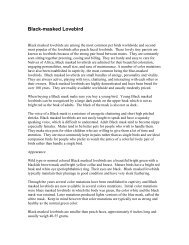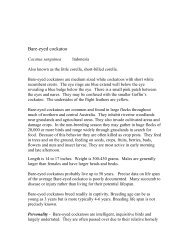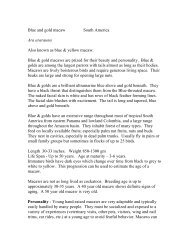Red Sided Eclectus Parrot Eclectus roratus ... - Susan Clubb
Red Sided Eclectus Parrot Eclectus roratus ... - Susan Clubb
Red Sided Eclectus Parrot Eclectus roratus ... - Susan Clubb
You also want an ePaper? Increase the reach of your titles
YUMPU automatically turns print PDFs into web optimized ePapers that Google loves.
Length - 12-14 inches. Body weight - 380-450 grams<br />
Life Span probably up to 30+ years<br />
Age at maturity 2-4 years.<br />
Juveniles had black eyes and variable colored beaks, often brownish or streaked with<br />
black and yellow. Adult eye color is yellow in females and more orange in males.<br />
Personality - <strong>Eclectus</strong> tend to be aloof and independent, much as a cat. They rarely talk<br />
well but if given adequate attention can make good companions, especially males.<br />
Females tend to be more aggressive however some owners have wonderful relationships<br />
with their female <strong>Eclectus</strong>. <strong>Eclectus</strong> are not as noisy as many other large parrot species<br />
although they can make a very loud, screeching call when alarmed. They can be a very<br />
nice addition to a garden aviary. <strong>Eclectus</strong> have a characteristic, slightly musky smell.<br />
Activities - <strong>Eclectus</strong> will often appear stoic, especially if nervous, but are interested in<br />
activities around them and love to chew. They should always be provided with toys,<br />
especially wooden blocks or other toys that can be chewed, and branches from non-toxic<br />
trees. In order to ensure safety companion eclectus should not be allowed unsupervised<br />
freedom in the home as they often encounter toxins or dangerous items. Young eclectus<br />
should be socialized to many people and exposed to a variety of situations such as new<br />
cages, toys, visits to the veterinarian, handling by friends, wing and nail clips, etc to<br />
avoid fear of novel situations.<br />
Dietary needs - <strong>Eclectus</strong> do well when provided with plenty of fruits and vegetables.<br />
<strong>Eclectus</strong> should be fed approximately ¼ to 1/3 cup of a formulated diet as a basis for<br />
good nutrition. The diet should be supplemented with the at least the same quantity of<br />
fresh fruits and vegetables daily to add variety and psychological enrichment. Treats<br />
maybe given in small amounts especially as rewards for good behavior. Fresh clean<br />
water must be provided every day. Vitamin supplements are not needed for birds that are<br />
eating a formulated diet. Some breeders feel the colors and flavors in many formulated<br />
diets may cause “toe tapping”. Exact original diet would be a good choice as it does not<br />
artificial colors.<br />
If eclectus are fed a seed diet it must be supplemented with vitamins. Fresh fruits and<br />
yellow vegetables are a good source of vitamin A. Vitaminized seed cannot be relied<br />
upon to supply adequate vitamins as the vitamins are applied to the shell of the seeds that<br />
is discarded by the parrot.<br />
Grooming - Routine bathing or showering is vital to maintaining good plumage and skin<br />
condition. The fine feathering of eclectus is especially beautiful when they receive<br />
routine baths. Ideally birds should be taken outdoors on a warm day and lightly sprinkled<br />
and allowed to dry in the sun. Indoor birds can be misted or bathed in the shower and<br />
allowed to dry in a warm room or dried with a blow drier.






